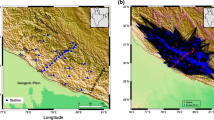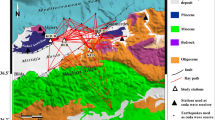Abstract
Seismic codas are usually characterized by the values of coda Q (Qc). However, interpretation of this quantity is often tricky because of its frequency dependence and acute sensitivity to subjective theoretical assumptions and processing parameters. Here, a simpler and physically more consistent parameterization of coda envelopes is proposed by noting that their temporal decay rates are often nearly frequency-independent. This weak frequency dependence shows that codas mostly consist of elastic reverberations and scattering on larger-scale structures, and the subwavelength-scale scattering and Q-type wave attenuation are weak. A recent study of the eastern Indian Shield by Singh et al. (in this journal) gives an illustration of such elastic coda. From that study, the inferred Qc steeply increases with frequency, lapse times, window lengths, and distances from the seismic station. However, we show that all of these dependencies of Qc represent a common artifact of the acquisition geometry and inversion procedure. In an alternate interpretation, we explain the same coda envelopes by two frequency-independent properties of the Earth’s subsurface: geometrical attenuation denoted γc,Earth and effective Q denoted Qc,Earth. Based on these parameters, the model becomes independent of theoretical assumptions and comparable to other areas, and the acquisition/inversion artifact is reduced. The estimated γc,Earth is above 0.01 s−1, which is also found in other areas of active tectonics. The effective attenuation is weak (Qc,Earth > 5700, likely below the measurable level), which is typical for stable tectonic areas. The data indicate near-surface resonances beneath the recording station. Effects of these resonances on coda envelopes also exceed those of Q-type attenuation. Thus, in the eastern Indian Shield and likely many other areas, coda envelopes are principally controlled by elastic structures such as crustal and near-surface layering, and not necessarily by the S-wave Q and uniformly-distributed random, small-scale scattering as commonly thought.

Source waveforms are schematically modeled by Gabor wavelets. Note that the scattering points are not necessarily located on a straight line









Similar content being viewed by others
References
Aki, K. (1969). Analysis of the seismic coda of local earthquakes as scattered waves. Journal of Geophysical Research, 74, 615–631.
Aki, K. (1980). Attenuation of shear waves in the lithosphere for frequencies from 0.05 to 25 Hz. Physics of the Earth and Planetary Interiors, 21, 50–60.
Aki, K., & Chouet, B. (1975). Origin of coda waves: source, attenuation, and scattering effects. Journal of Geophysical Research, 80, 3322–3342.
Aki, K., & Richards, P. G. (2002). Quantitative seismology (2nd ed.). Sausalito: University Science Books.
Atkinson, G. M. (2004). Empirical attenuation of ground-motion spectral amplitudes in southeastern Canada and the northeastern United States. Bulletin of the Seismological Society of America, 94, 1079–1095.
Blanke, A., Kwiatek, G., Martínez-Garzón, P., & Bohnhoff, M. (2019). Sensitivity and stability analysis of coda quality factors at the Geysers geothermal field, California. Bulletin of the Seismological Society of America, 109, 959–975. https://doi.org/10.1785/0120180219
Bouchon, M. (1982). The complete synthesis of seismic crustal phases at regional distances. Journal of Geophysical Research, 87, 1735–1741.
Campillo, M. (1987). Lg wave propagation in a laterally varying crust and the distribution of the apparent quality factor in central France. Journal of Geophysical Research, 92, 12604–12614.
Dainty, A. M. (1981). A scattering model to explain seismic Q observations in the lithosphere between 1 and 30 Hz. Geophysical Research Letters, 8, 1126–1128.
Del Pezzo, E., Ibañez, J., Prudencio, J., Bianco, F., & De Siena, L. (2016). Absorption and scattering 2-D volcano images from numerically calculated space-weighting functions. Geophysical Journal International, 206, 742–756. https://doi.org/10.1093/gji/ggw171
Escudero, C. R., García-Millán, N., & Escalona-Alcázar, F. J. (2016). Attenuation of coda waves in western Mexico using local seismicity. Bulletin of the Seismological Society of America, 106, 2545–2557. https://doi.org/10.1785/0120160027
Fehler, M., & Sato, H. (2003). Coda. Pure and Applied Geophysics, 160, 541–554.
Fehr, M., Kremers, S., & Fritsche, R. (2019). Characterisation of seismic site effects influenced by near-surface structures using 3D waveform modelling. Journal of Seismology, 23, 373–392.
Frankel, A., & Wennerberg, L. (1987). Energy-flux model of seismic coda: Separation of scattering and intrinsic attenuation. Bulletin of the Seismological Society of America, 77, 1223–1251.
Giampiccolo, E., & Tuvè, T. (2018). Regionalization and dependence of coda Q on frequency and lapse time in the seismically active Peloritani region (northeastern Sicily, Italy). Journal of Seismology, 22, 1059–1074. https://doi.org/10.1007/s10950-018-9750-0
Havskov, J., Sørensen, M. B., Vales, D., Özyazıcıoğlu, M., Sánchez, G., & Li, B. (2016). Coda Q in different tectonic areas, influence of processing parameters. Bulletin of the Seismological Society of America, 106, 956–970. https://doi.org/10.1785/0120150359
Jhajhria, A., Morozov, I. B., & Teotia, S. S. (2017). Frequency-dependent coda amplitude decays in the region of Himalaya. Bulletin of the Seismological Society of America, 107, 1817–1827. https://doi.org/10.1785/0120170032
Mitchell, B. (2010). Prologue and invitation to participate in a forum on the frequency dependence of seismic Q. Pure and Applied Geophysics, 167, 1129. https://doi.org/10.1007/s00024-010-0180-3
Mitchell, B. J., & Cong, L. (1998). Lg coda Q and its relation to the structure and evolution of continents: a global perspective. Pure and Applied Geophysics, 153, 655–663.
Morozov, I. B. (2008). Geometrical attenuation, frequency dependence of Q, and the absorption band problem. Geophysical Journal International, 175, 239–252.
Morozov, I. B. (2010b). Attenuation coefficients of Rayleigh and Lg waves. Journal of Seismology, 14, 803–822. https://doi.org/10.1007/s10950-010-9196-5
Morozov, I. B. (2010a). On the causes of frequency-dependent apparent seismological Q. Pure and Applied Geophysics, 167, 1131–1146. https://doi.org/10.1007/s00024-010-0100-6
Morozov, I. B. (2011). Mechanisms of geometrical seismic attenuation. Annals of Geophysics, 54(3), 235–248. https://doi.org/10.4401/ag-4780
Morozov, I. B. (2013). Frequency dependence of long-period t*. Journal of Seismology, 17, 265–280. https://doi.org/10.1007/s10950-012-9315-6
Morozov, I., Zhang, C., Duenow, J. N., Morozova, E. A., & Smithson, S. B. (2008). Frequency dependence of coda Q, Part I: Numerical modeling and examples from Peaceful Nuclear Explosions. Bulletin of the Seismological Society of America, 98, 2615–2628. https://doi.org/10.1785/0120080037
Morozov, I. B., Jhajhria, A., & Deng, W. (2018). On strong positive frequency dependencies of quality factors in local-earthquake seismic Studies. Pure and Applied Geophysics, 175, 2595–2607. https://doi.org/10.1007/s00024-018-1826-9
Nishigami, K. (1997). Spatial distribution of coda scatterers in the crust around two active volcanoes and one active fault system in central Japan: Inversion analysis of coda envelope. Physics of the Earth and Planetary Interiors, 104, 75–89.
Nishigami, K. (2006). Crustal heterogeneity in the source region of the 2004 Mid Niigata Prefecture earthquake: inversion analysis of coda envelopes. Pure and Applied Geophysics, 163, 601–616. https://doi.org/10.1007/s00024-005-0024-8
Parvez, A. K., Mridula, S. M., Mishra, S. K., & Rai, S. S. (2008). Coda Q estimates in the Andaman Islands using local earthquakes. Pure and Applied Geophysics, 165, 1861–1878. https://doi.org/10.1007/s00024-008-0399-4
Safarshahi, M., & Morozov, I. B. (2020). Robust empirical time-frequency relations for seismic spectral amplitudes, Part 1: Application to regional S waves in southeastern Iran. Bulletin of the Seismological Society of America. https://doi.org/10.1785/0120200172
Sato, H. (1977). Energy propagation including scattering effects single isotropic scattering approximation. Journal of Physics of the Earth, 25(1), 27–41.
Singh, R., Sharma, S., Mitra, S., & Khan, P. K. (2019). Mapping of coda-wave attenuation and its frequency dependency over eastern Indian Shield. Pure and Applied Geophysics, 176, 5291–5313. https://doi.org/10.1007/s00024-019-02284-3
Tsujiura, M. (1978). Spectral analysis of the coda waves from local earthquakes. Bulletin of the Earthquake research Institute, University of Tokyo, 53, 1–48.
Xie, J., & Mitchell, B. (1990). A back-projection method for imaging large-scale lateral variation of Lg coda Q with application to continental Africa. Geophysical Journal International, 100, 161–181.
Zeng, Y., Su, F., & Aki, K. (1991). Scattering wave energy propagation in a random isotropic scattering medium 1. Theory, 96, 607–619.
Acknowledgements
Although the authors of Singh et al. (2019) did not wish to participate in revisiting their results, we highly commend the quality and detail of presentation in their paper. This detail has facilitated the additional analysis carried out in the present paper. Comments and discussions by two anonymous reviewers have contributed to improving this manuscript. This study was funded by the Natural Sciences and Engineering, Natural Sciences and Engineering Research Council of Canada.
Author information
Authors and Affiliations
Corresponding author
Additional information
Publisher's Note
Springer Nature remains neutral with regard to jurisdictional claims in published maps and institutional affiliations.
Rights and permissions
About this article
Cite this article
Morozov, I.B., Safarshahi, M. Elastic Character of Seismic Coda Envelopes Within East Indian Shield. Pure Appl. Geophys. 177, 5799–5818 (2020). https://doi.org/10.1007/s00024-020-02600-2
Received:
Revised:
Accepted:
Published:
Issue Date:
DOI: https://doi.org/10.1007/s00024-020-02600-2




